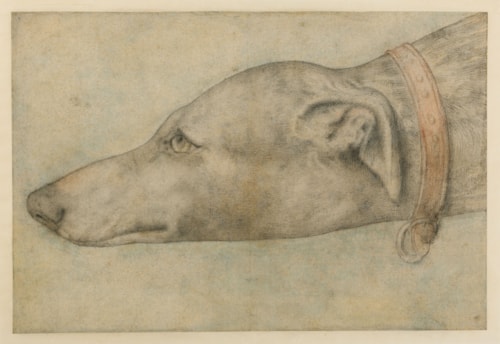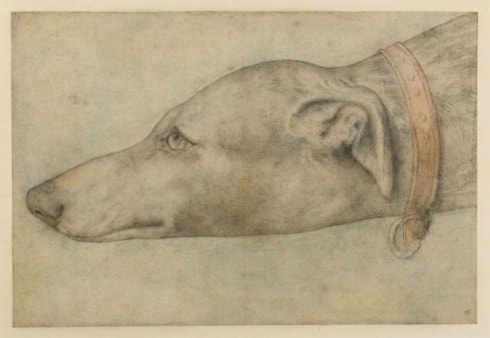
Circle of ANTONIO DI PUCCIO PISANO, called PISANELLO
Verona or Pisa 1394 - Rome or Naples 1455
Biography
A painter, draughtsman and medallist from Verona, Antonio di Puccio, known as Pisanello, enjoyed a long and highly successful career. He was probably born and grew up in Verona, but nothing is known of his training or early life before 1424, when he appears in a document already described as a ‘distinguished painter’ (‘pictor egregius’), and 1425, when his name is recorded for the first time in the account books of the Gonzaga family in Mantua. Pisanello travelled extensively throughout Italy, working in Verona, Pavia, Rome, Ferrara, Milan, Mantua and Naples. He enjoyed the patronage of some of the most powerful and sophisticated courts in Italy, receiving important commissions from the Gonzaga in Mantua, the d’Este in Ferrara and Alfonso V of Aragon, King of Naples, as well as Filippo Maria Visconti, Duke of Milan, and Popes Martin V, Eugenius IV and Nicholas V. One of the finest medallists in Italy, Pisanello produced a number of striking portrait medallions from the 1430s onwards. Despite his concurrent fame as a painter, however, very few of his paintings have survived to this day. Indeed, only four or five panel paintings and three frescoed mural compositions – two in churches in Verona and the other in the Palazzo Ducale in Mantua, all in poor condition – exist today from his oeuvre as a painter.
As a draughtsman, however, Pisanello is better known. Around four hundred drawings by Pisanello and his workshop are known today, of which by far the largest group is now in the Louvre. (Almost all of the Louvre drawings come from an album acquired by the museum in 1856 from the Milanese print publisher and dealer Giuseppe Vallardi.) The range and variety of extant drawings by Pisanello and artists of his circle allow for a closer understanding of the master’s working methods. When planning a composition, Pisanello ‘would employ his own ‘pattern’ drawings from stock, often very finished and beautiful – drawings above all of birds and animals – and also make new sketches for specific elements for the project in hand…Pisanello would also execute a series of finished studies on a particular theme. These would provide him with a corpus from which he could select one or more drawings to be used in the final painting, and which he could use again as workshop patterns in the future. Such drawings usually represent animals, drawn from life – for example hounds…and, above all, horses.’
As has recently been noted, Pisanello ‘can be considered the most imaginative and versatile artist of the early Quattrocento, as his drawings show an unparalleled range of subjects and inventions. Around 400 sheets from his workshop have survived, and at least 100 of these are by Pisanello himself. Through his elegant and distinctive individual style, the figure of a master, separate from the members of the workshop, emerges for the first time.’ However, there has long been scholarly debate around the extent of Pisanello’s drawn oeuvre, with scholars such as Bernard Degenhart and, to some extent, Dominique Cordellier, taking a more expansive view of the corpus of autograph drawings, while earlier art historians, notably Maria Fossi Todorow, reattributed many drawings to members of Pisanello’s studio. As Luke Syson has noted, Pisanello ‘had a large workshop, and he needed to be able to rely on its members to be able to reproduce his motifs and his techniques. To this end they were trained, partly in the traditional way, by copying drawings. But Pisanello also appears to have taught his pupils to draw from life.’ Pisanello’s only firmly documented pupil, however, is the obscure Bono da Ferrara, who was active between 1441 and 1461.


